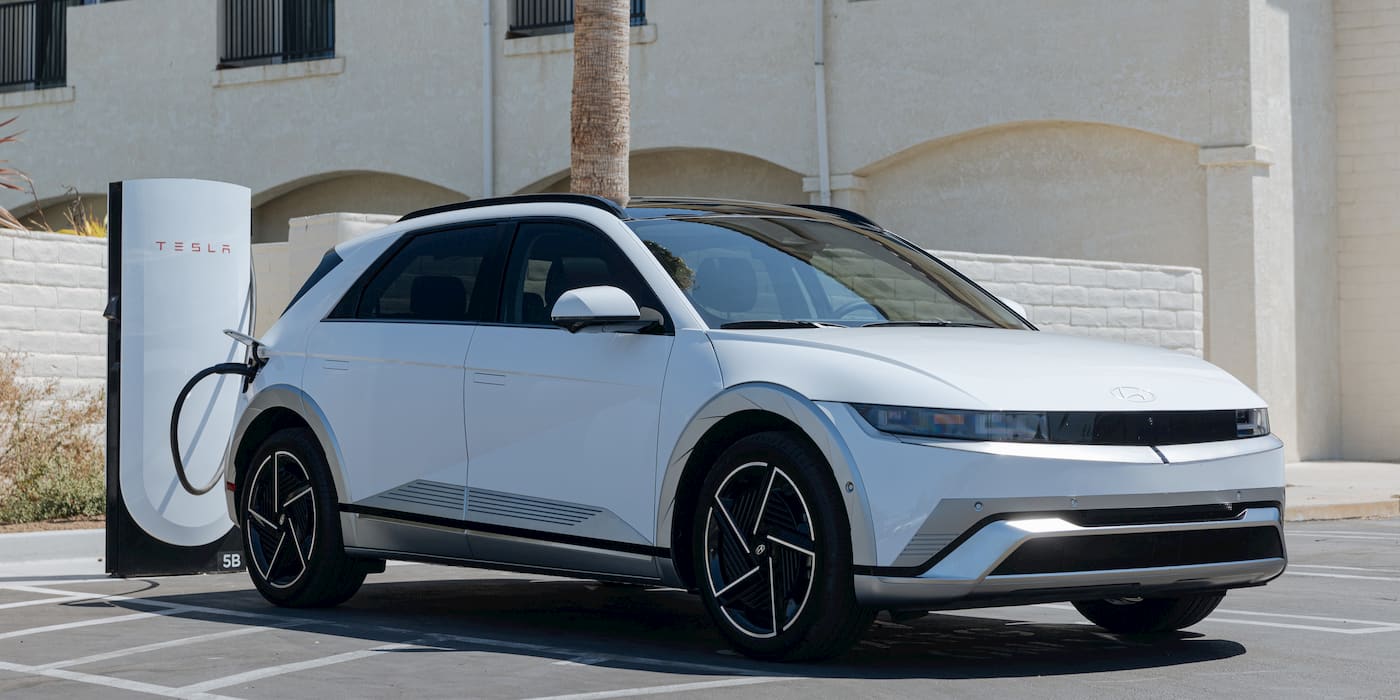
With the release of Hyundai’s 2025 Ioniq 5 with native NACS port, owners are heading to Tesla Superchargers to see how the experience is. And it turns out, the away team is beating the home team at charging speed… at least in some metrics.
This has been a busy time for the transition to NACS, the new EV charging standard for North America that was originally advanced by Tesla and now standardized by SAE.
We’ve seen several brands added to Tesla’s “coming soon” list for Supercharger access, and even beyond that, VW and Honda have both made their own announcements that access is coming soon. But we’ve also had a setback, as Kia announced access would be delayed (though some owners are finding ways to charge anyway).
Hyundai is one of the brands that was added to the “coming soon” list, but it also already released a vehicle with a native NACS port, and several of them are out in the wild. Given that the car includes the right port to charge on a Supercharger, it ought to be able to charge no problem, right?
Well, owners are finding that it can, if they go through the normal process for third party vehicles on Tesla Superchargers (download the app, set up payment information, start charge sessions through app, etc) and have the proper adapters or a 2025 car with native NACS. Hyundai hasn’t made it official yet, but it seems plenty possible.
And today we saw one test that shows Hyundai beating Tesla in one metric, even on Tesla’s home turf.
Out of Spec reviews took a Tesla Model 3 and a 2025 Hyundai Ioniq 5 with native NACS port to a local Tesla Supercharger to do a 1v1 charging test, and find out which vehicle charges better and faster on Tesla’s network.
The Ioniq 5 is based on Kia/Hyundai’s joint E-GMP platform, which has been hailed for its exceptional charging performance.
Despite it having a lower peak charge rate than some other vehicles (it tops out at around 230kW), it has an exceptionally broad charging curve, which means that it can maintain that peak charge rate for longer than other vehicles. Other vehicles start charging fast, but slow down rapidly as the battery fills up.
The upshot of this is that charging sessions will be faster with a broad charge curve, as long as you’re charging up to a high state of charge. Hyundai says the Ioniq 5 can charge from 10-80% in just 18 minutes, making it the current charging speed champion (and the Ioniq 6 charges even faster in terms of “miles per minute,” if you account for vehicle efficiency – more on that later).
That broad charge curve shined in Out of Spec’s side-by-side test, which you can see on its YouTube channel. The two cars have similar battery sizes, so it’s actually a pretty close test.
In the test, the Model 3, charging on home turf, charged for 31 minutes and 53 seconds, and 55.7kWh was delivered from the charger to the vehicle.
But the upstart Ioniq 5 managed to gain 59.6kWh in 30 minutes and 37 seconds, a slightly shorter time and slightly more energy delivered.
Those numbers are close enough to call it a wash, but still an impressive showing on away turf.
The victory is all the greater when considering that the Hyundai isn’t even charging at full power. The E-GMP platform uses an 800 volt architecture, and Tesla’s Superchargers mostly use 400 volts (the new V4 Supercharger will provide 400-1000 volts, but most in the wild are V3).
This means that the Ioniq 5 could only achieve a peak charge rate of 123kW in the test, which is nevertheless improved from the ~100kW that earlier model year E-GMP cars have seen when charging at Superchargers. But that’s far lower than the 250kW peak the Model 3 can reach.
But that aforementioned charge curve is still what ended up winning out. Slow and steady won this race.
There were a few difficulties in this specific test. For some reason, the Ioniq 5 randomly stopped charging, and Out of Spec couldn’t figure out why, and had to spend time restarting the charge session – which thankfully didn’t take that long, due to the much faster handshake speed to start charging sessions on Superchargers as compared to CCS stations.
The interruption also meant that the Hyundai had to ramp up its charging speed again. It may also be difficult to precondition a Hyundai – warming the battery to achieve better charging speeds – because so far, Tesla stations aren’t included in Ioniq 5’s navigation system, so preconditioning won’t happen automatically. An update should come soon to enable that.
However, this wasn’t a total victory for the Ioniq 5. Despite achieving a faster charge rate and getting more total energy, the Model 3 still won out in the most important practical metric – miles per minute.
Energy really doesn’t matter that much, what matters is how far it can get you. And the Model 3 is much more efficient than the Ioniq 5. While the cars have similarly-sized batteries, Tesla says the Model 3 can go 363 miles, whereas Hyundai says the Ioniq 5 can go 303 miles. Account for that ~20% higher efficiency, and the Model 3 won today’s test handily.
Now, if we were to try the same test with an Ioniq 6…
But when you’re charging at *home*, charge your electric vehicle using rooftop solar panels. Find a reliable and competitively priced solar installer near you on EnergySage, for free. They have pre-vetted installers competing for your business, ensuring high-quality solutions and 20-30% savings. It’s free, with no sales calls until you choose an installer. Compare personalized solar quotes online and receive guidance from unbiased Energy Advisers. Get started here. – ad*
FTC: We use income earning auto affiliate links. More.


![Here's our first official look at the new Hyundai EV debuting next month [Images]](https://i0.wp.com/electrek.co/wp-content/uploads/sites/3/2025/08/hyundai-ioniq-2-first-look.jpeg?resize=1200,628&quality=82&strip=all&ssl=1)









